GARDENS BY THE BAY
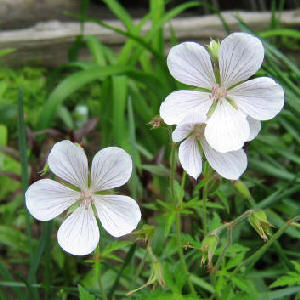
WHITE PERENNIALS & THEIR COMPANIONS - 1
Care must be taken when adding white-flowered perennials to the garden. You may well end up with a different effect from the one you intended. Shades range from the stark, jarring white of perennials such as Shasta Daisy to more muted, creamy tones of many other perennials. Combine the white-flowered perennials below with plants recommended and your garden will reward you with enhanced beauty.
* Watch for the animated hummingbird and butterfly with the plants that attract them. *
The deer icon indicates plants that deer are not usually attracted to.
   The best time and method to propagate plants can be found on our image-intensive PROPAGATION page.
To help your plants grow their best, check out our FERTILIZATION page.
To create your own plant partnerships based on tried and true color theory, check out our GARDEN COLOR page.
To see if a particular plant is on this page press Ctrl+F, type in the name, then click the Find button.
The best time and method to propagate plants can be found on our image-intensive PROPAGATION page.
To help your plants grow their best, check out our FERTILIZATION page.
To create your own plant partnerships based on tried and true color theory, check out our GARDEN COLOR page.
To see if a particular plant is on this page press Ctrl+F, type in the name, then click the Find button.
ACHILLEA
 Is your garden hot and dry? Is your soil poor? The Yarrows may just be your perfect low maintenance choice. Divide them in early spring or fall every two to three years to keep them flourishing.
Achillea ageratum 'W. B. Child': small white daisy flowers with green eye, 36"
Is your garden hot and dry? Is your soil poor? The Yarrows may just be your perfect low maintenance choice. Divide them in early spring or fall every two to three years to keep them flourishing.
Achillea ageratum 'W. B. Child': small white daisy flowers with green eye, 36"
uses: perennial borders, cut flower arrangements
for all-white effect with: Heuchera 'June Bride'
Achillea ptarmica 'The Pearl': Sneezewort, a pure white double form
with: Delphinium (blue forms)
Looking for Yarrows of other colours? Try the links below.
orange Yarrows
pink Yarrows
red Yarrows
Yarrows with silver foliage
yellow Yarrows
ACIDANTHERA
Fragrant Gladiolus is tall, very long-lasting, has extremely fragrant flowers on stems arising from sword-like foliage, 4-6 per stem and looking like "Glads". Also known as Abyssinian Gladiolus or Peacock Orchid, their corms must be lifted each fall and overwintered indoors. Perfect for a touch of the exotic in your gardens.
Acidanthera bicolor: Fragrant Gladiolus, annual Zones 3-6, white with purple blotch
to follow: Mertensia virginica, Doronicum caucasicum
ALCEA
 Towering Hollyhocks, from 3 to 7 feet, produce single or double flowers with crinkled petals, opening from the bottom to the top. They are easily propagated by seed sown in fall where you want then to grow. Plants may bloom the first year but are actually biennials, producing foliage the first year and flowers the second.
Alcea: Hollyhock, tall white forms including white 'Chater's Double'
Towering Hollyhocks, from 3 to 7 feet, produce single or double flowers with crinkled petals, opening from the bottom to the top. They are easily propagated by seed sown in fall where you want then to grow. Plants may bloom the first year but are actually biennials, producing foliage the first year and flowers the second.
Alcea: Hollyhock, tall white forms including white 'Chater's Double'
beside: Gypsophila paniculata
behind: Achillea (a 3' yellow form)
behind: Baptisia australis, Paeonia, Dictamnus, Aconitum
If white Hollyhocks aren't your favourite, try some of the other colours below. You may find useful information about growing this plant well on each of the pages.
orange Hollyhocks
pink Hollyhocks
red Hollyhocks
yellow Hollyhocks
Hollyhocks to attract Hummingbirds
ALLIUM
  The choices among the Ornamental Onions are so varied you'll want to Google them to find the ones you want to try. Hopefully these partnership ideas can direct you to a few you can use with plants already in your gardens.
Allium tuberosum: Chinese Chives, Garlic Chives, Ornamental Garlic, starry white
The choices among the Ornamental Onions are so varied you'll want to Google them to find the ones you want to try. Hopefully these partnership ideas can direct you to a few you can use with plants already in your gardens.
Allium tuberosum: Chinese Chives, Garlic Chives, Ornamental Garlic, starry white
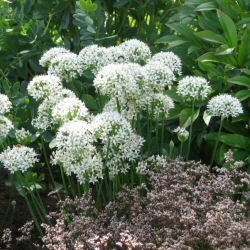
seen above offset behind: Limonium latifolium just beginning to bloom
under: small shrubs or roses
beside: Limonium latifolium, Helianthemum 'Wisley Pink'
behind: Sedum 'Vera Jameson'
in front of: Linaria purpurea 'Canon Went'
Many more Allium forms and the plants that complement them can be found by following the links below.
blue Allium forms
various Allium forms
ANEMONE
 Another genus of nearly unlimited choices, the Anemones have something for everyone, from early spring to fall bloomers, from edgers to mid-border choices and from sun to shade lovers.
Anemone blanda 'White Splendor': Grecian Windflower
Anemone x hybrida 'Honorine Jobert': Japanese Anemone, compact 3-4'
Anemone x hybrida 'Whirlwind': pure white semi-double, 4 feet tall
Another genus of nearly unlimited choices, the Anemones have something for everyone, from early spring to fall bloomers, from edgers to mid-border choices and from sun to shade lovers.
Anemone blanda 'White Splendor': Grecian Windflower
Anemone x hybrida 'Honorine Jobert': Japanese Anemone, compact 3-4'
Anemone x hybrida 'Whirlwind': pure white semi-double, 4 feet tall
with: Aster, ferns, Ornamental Grasses, tall Dahlia
Anemone nemorosa: Wood Anemone
If you want more plants from this wonderful genus in your garden, you might want to have a look at the other forms below.
blue Anemone forms
pink Anemone forms
Anemones for shade
AQUILEGIA
 Taylor's Guide to Growing North America's Favorite Plants has this to say about the Columbines. "The word "columbine" is from the Latin columbinus, meaning "like a dove", or columba meaning "dove". When looked at from above, the petals of short-spurred types resemble doves with their tails in the air, hence the common names doves-in-a-ring and doves-round-a-dish.".
Aquilegia flabellata var. nana alba: Fan Columbine
There are colours and colour combinations of Columbine to suit other plants already in your garden. And if your columbines aren't doing well you might find out why with the additional information on the following pages.
pink Columbines
red Columbines
various other Columbines
Columbines to attract Hummingbirds
Taylor's Guide to Growing North America's Favorite Plants has this to say about the Columbines. "The word "columbine" is from the Latin columbinus, meaning "like a dove", or columba meaning "dove". When looked at from above, the petals of short-spurred types resemble doves with their tails in the air, hence the common names doves-in-a-ring and doves-round-a-dish.".
Aquilegia flabellata var. nana alba: Fan Columbine
There are colours and colour combinations of Columbine to suit other plants already in your garden. And if your columbines aren't doing well you might find out why with the additional information on the following pages.
pink Columbines
red Columbines
various other Columbines
Columbines to attract Hummingbirds
ARABIS
 Rock Cress is a wonderful and easy alpine plant, perfect for spilling over rock edges. Its thick gray-green foliage is smothered in spring with small flowers that are sweetly scented. Like most alpines, it does best in well-drained, gritty soil in full sun.
Arabis caucasica 'Flore Plena': Rock Cress
Arabis caucasica 'Snowcap'
For additional specific Rock Cress forms and helpful information as well, click on the following links.
Arabis as edgers
pink Arabis
Arabis with variegated foliage
Rock Cress is a wonderful and easy alpine plant, perfect for spilling over rock edges. Its thick gray-green foliage is smothered in spring with small flowers that are sweetly scented. Like most alpines, it does best in well-drained, gritty soil in full sun.
Arabis caucasica 'Flore Plena': Rock Cress
Arabis caucasica 'Snowcap'
For additional specific Rock Cress forms and helpful information as well, click on the following links.
Arabis as edgers
pink Arabis
Arabis with variegated foliage
ARENARIA
Another easy alpine plant, Sandwort also requires good drainage and full sun, perfect for a sunny rock garden with neutral to slightly acidic soil. This is a diminutive perennial, growing only 2-4" tall. Leaves are narrow and form a low cushion covered in spring with starry 5-petalled blooms.
Arenaria montana: Mountain Sandwort
where: between pavers in walkways, in open walls, rock gardens, in pots, trough gardens
ARTEMISIA
 Most Artemisias, or Wormwoods, are grown for their aromatic, shrubby foliage as their flowers are small and insignificant. Not so for those described below. Try them and enjoy their late summer creamy-white flowers held high above their bright green leaves.
Artemisia: Wormwood
Most Artemisias, or Wormwoods, are grown for their aromatic, shrubby foliage as their flowers are small and insignificant. Not so for those described below. Try them and enjoy their late summer creamy-white flowers held high above their bright green leaves.
Artemisia: Wormwood
next to : pink, purple and light blue shades (because of the silvery leaves, not the colour of the flowers)
Artemisia 'Guizho': creamy-white
with: Hemerocallis, Monarda (red), Crocosmia, Heliopsis & Rudbeckia
Artemisia lactiflora: White Mugwort
with: Dahlia
with: red Monarda didyma, Echinops ritro, lemon-yellow Hemerocallis
behind: Achillea 'Moonshine'
with: late summer daisies i.e. Rudbeckia, Helenium
excellent behind: Miscanthus sinensis 'Variegatus'
combined with: Lobelia 'Compliment Scarlet', Monarda 'Gardenview Scarlet' & Rudbeckia 'Goldsturm'
behind: Helenium autumnale
If you prefer some of the Artemisias grown for their wonderful foliage, you will find many at the link below.
Artemisias for edging
Artemisias with silver foliage
ARUNCUS
 For its 4-6 foot height and spread alone, Goatsbeard deserves a featured position at the rear of your perennial border. For positions further forward you might want to try one of the shorter-statured forms. Foliage is light green and feathery off-white florets appear above to dominate the early summer garden.
Aruncus aesthusifolius: Dwarf Goatsbeard
Aruncus dioicus: Goat's Beard
Aruncus dioicus 'Kneiffii'
More information about Goatsbeard can be found at the following link.
Goatsbeard in shade
For its 4-6 foot height and spread alone, Goatsbeard deserves a featured position at the rear of your perennial border. For positions further forward you might want to try one of the shorter-statured forms. Foliage is light green and feathery off-white florets appear above to dominate the early summer garden.
Aruncus aesthusifolius: Dwarf Goatsbeard
Aruncus dioicus: Goat's Beard
Aruncus dioicus 'Kneiffii'
More information about Goatsbeard can be found at the following link.
Goatsbeard in shade
ASCLEPIAS
  This meadow favourite is known by many common names including Chigger Flower, Indian Paintbrush, Pleurisy Root and Tuberroot as well as Butterfly Weed. Its fragrant flowers will draw butterflies to your garden during summer. Attractive seedpods will form after blooming ends. For long-lasting arrangements, the stems should be seared after cutting, before being put into water. Bonus - Butterfly Weed is a host plant for the Monarch butterfly and supplies nectar for many other butterfly species as well.
Asclepias 'Ice Ballet': White Butterfly Weed
White is certainly not the only colour of Butterfly Weed flowers. Try the links below for more.
various Butterfly Weed forms
orange Butterfly Weed
This meadow favourite is known by many common names including Chigger Flower, Indian Paintbrush, Pleurisy Root and Tuberroot as well as Butterfly Weed. Its fragrant flowers will draw butterflies to your garden during summer. Attractive seedpods will form after blooming ends. For long-lasting arrangements, the stems should be seared after cutting, before being put into water. Bonus - Butterfly Weed is a host plant for the Monarch butterfly and supplies nectar for many other butterfly species as well.
Asclepias 'Ice Ballet': White Butterfly Weed
White is certainly not the only colour of Butterfly Weed flowers. Try the links below for more.
various Butterfly Weed forms
orange Butterfly Weed
ASTER
 With selections of every type, from short-statured early spring bloomers to tall fall-blooming specimens, there is something for everyone in the Aster genus, including the white form below. All need full sun to partial shade and fertile, well-drained soil with adequate moisture during the growing season.
Aster novae-angliae 'Autumn Snow': New England Aster, Michaelmas Daisy
Try any of the links below to find numerous other Asters for various garden situations, of varying heights and in numerous other coloured forms.
various Aster forms
blue Asters
pink Asters
purple Asters
Asters for shade
With selections of every type, from short-statured early spring bloomers to tall fall-blooming specimens, there is something for everyone in the Aster genus, including the white form below. All need full sun to partial shade and fertile, well-drained soil with adequate moisture during the growing season.
Aster novae-angliae 'Autumn Snow': New England Aster, Michaelmas Daisy
Try any of the links below to find numerous other Asters for various garden situations, of varying heights and in numerous other coloured forms.
various Aster forms
blue Asters
pink Asters
purple Asters
Asters for shade
ASTILBE
 Flowering in panicles or spikes, the Astilbe has numerous forms for every situation - from rockeries to perennial border specimens. Appreciating an annual mulch in spring with well-rotted compost, most forms, including the white forms below, grow best in partial shade.
Astilbe: Astilbe, False Spirea, white forms
Astilbe 'Bridal Veil'
Do you prefer Astilbes in other colours or for specific garden situations? Try the link below to find some that will suit your taste or your garden needs.
Astilbe as edgers
pink Astilbe
various Astilbe
Flowering in panicles or spikes, the Astilbe has numerous forms for every situation - from rockeries to perennial border specimens. Appreciating an annual mulch in spring with well-rotted compost, most forms, including the white forms below, grow best in partial shade.
Astilbe: Astilbe, False Spirea, white forms
Astilbe 'Bridal Veil'
Do you prefer Astilbes in other colours or for specific garden situations? Try the link below to find some that will suit your taste or your garden needs.
Astilbe as edgers
pink Astilbe
various Astilbe
ASTRANTIA
Masterwort has interesting starry flowers surrounded by sharp bracts. Although this genus prefers moist shady borders it is adaptable to other sites. Different species provide varying colour choices, including pinks, reds, whites and greenish-white. Because it self-seeds, you will soon have a lovely patch to invite visitors' comments.
Astrantia major: Masterwort, 30"x18"

where: along borders, beside ponds or streams
with: Thalictrum, spiky Verbascum, Ferns, Ornamental Grasses, Alchemilla mollis
in moist soil with: Iris ensata, Iris sibirica
in drier soil with: Iris x germanica, Artemisia,
Penstemon
combined with: Iris sibirica 'Little White', diminutive Geranium 'Ballerina' and Heuchera 'Pluie de Feu' (cherry-red)
BAPTISIA
 Gray-green foliage and spikes of pea-like flowers cover the shrub-like 3-4 foot tall Plains False Indigo, also known as Blue False Indigo by early summer. Best in a sunny location as well as in well-drained, humusy soil a little on the acidic side.
Baptisia alba: white Wild Indigo
Gray-green foliage and spikes of pea-like flowers cover the shrub-like 3-4 foot tall Plains False Indigo, also known as Blue False Indigo by early summer. Best in a sunny location as well as in well-drained, humusy soil a little on the acidic side.
Baptisia alba: white Wild Indigo
interplanted with: Aquilegia canadensis
BERGENIA
 Another vigorous perennial, Heartleaf Bergenia produces spires of mid-spring blooms. But it is the foliage that predominates. Huge, glossy, leathery leaves are evergreen, taking on reddish tones in fall and winter. Preferring moist well-drained soil with plenty of humus-rich organic matter, it tolerates some drought once established. Plant in groups for best effect.
Bergenia 'Bressingham White': white Bergenia, snowy white fading to pink
Another vigorous perennial, Heartleaf Bergenia produces spires of mid-spring blooms. But it is the foliage that predominates. Huge, glossy, leathery leaves are evergreen, taking on reddish tones in fall and winter. Preferring moist well-drained soil with plenty of humus-rich organic matter, it tolerates some drought once established. Plant in groups for best effect.
Bergenia 'Bressingham White': white Bergenia, snowy white fading to pink
also commonly known as: white Pigsqueak, white Elephant Ears
with: all spring-flowering shrubs & bulbs
with: Helleborus
If you prefer the colour pink, follow the link below.
pink Bergenia
BOLTONIA
 I've never grown Boltonia, mainly because I'm not partial to white flowers. But if I wanted masses of aster-like flowers on a tall plant in late summer to early fall, this would probably be what I'd choose. Growing from 3-5 feet tall, it looks best planted in masses in well-drained, humusy soil in sun to light shade. Put it in a mid to rear border position and keep it moist.
Boltonia asteroides 'Snowbank': white Boltonia
I've never grown Boltonia, mainly because I'm not partial to white flowers. But if I wanted masses of aster-like flowers on a tall plant in late summer to early fall, this would probably be what I'd choose. Growing from 3-5 feet tall, it looks best planted in masses in well-drained, humusy soil in sun to light shade. Put it in a mid to rear border position and keep it moist.
Boltonia asteroides 'Snowbank': white Boltonia
with: tall Aster, Helenium, Eupatorium purpureum (a larger 'Purpurea'), Physostegia virginiana 'Vivid'
with: bright coloured Aster such as 'Alma Potschke'
combined with: Physostegia 'Variegata', Cornus 'Elegantissima' & Angelica gigas
If, like me, you prefer other colours to white, try the link below.
pink Boltonia
CALAMINTHA
Are you looking for a short-statured 18 inch tall mid-summer to fall blooming perennial with clouds of dainty flowers and aromatic leaves. Try the Lesser Calamint in well-drained soil in full sun to light shade. Another good edger in the border or rock garden.
Calamintha nepetoides: white Beautiful Mint
combined with: Gentiana 'Benichidori', Geranium 'Wargrave Pink' & Stokesia 'Blue Danube'
CAMPANULA
 Short or tall, well-behaved or invasive, the Bellflowers have a number of white forms in addition to the mainly purple ones I tend to go for first. They prefer lots of organic matter mixed into their planting site. Good drainage and even moisture will encourage their best performance.
Campanula carpatica alba: pure white Bellflower, white Carpathian Harebell
Short or tall, well-behaved or invasive, the Bellflowers have a number of white forms in addition to the mainly purple ones I tend to go for first. They prefer lots of organic matter mixed into their planting site. Good drainage and even moisture will encourage their best performance.
Campanula carpatica alba: pure white Bellflower, white Carpathian Harebell
with: Campanula carpatica (purple forms)
Campanula carpatica 'White Clips'
under: wine-red Lilium, dwarf shrubs
beside: Helictotrichon sempervirens, Stachys byzantina
in front of: Hemerocallis, Chrysopsis 'Mariana'
with: pink or yellow Sedum, Sedum spectabile 'Carmen'
Campanula glomerata: Clustered Bellflower, white, 12-18"
with: ferns, orangish-apricot tones i.e. Lychnis hybrids
Campanula persicifolia: white Peach-Leaved Bellflower
in light shade with: Digitalis
sandwiched between: Alchemilla mollis (in front) & old roses (behind)
Campanula persicifolia 'Alba': Peach-Leaved Bellflower

under: well-spaced white birch or maples
with: naturalized Digitalis & wild Aster
behind: Geranium sanguineum, Primula polyanthes, Hosta 'Medio-Variegata'
in front of: Delphinium, Lilium, Polemonium caeruleum
Campanula pyramidalis 'Alba': Chimney Bellflower
with: Campanula pyramidalis (purple shades)
Bellflowers come in many other colours as you will see below. Additional information about growing them well will be found at each of the following links.
blue Bellflowers
pink Bellflowers
purple Bellflowers
CHRYSANTHEMUM
  Much reclassification has taken place in the genus Chrysanthemum. The references below use the original names with new names beneath for clarity. My references say that plants reclassified as Leucanthemum are the one which deer do not normally eat, and that butterflies are especially attracted to those reclassified as Tanacetum. Check out which ones that includes in the current names below.
Chrysanthemum parthenium: Feverfew
Much reclassification has taken place in the genus Chrysanthemum. The references below use the original names with new names beneath for clarity. My references say that plants reclassified as Leucanthemum are the one which deer do not normally eat, and that butterflies are especially attracted to those reclassified as Tanacetum. Check out which ones that includes in the current names below.
Chrysanthemum parthenium: Feverfew
now: Tanacetum parthenium
where: in dry shade
with: bold flowers & foliage (as a filler)
with: pink Phlox paniculata, Campanula poscharskyana, small Ornamental Grasses, Coreopsis grandiflora
in front of: Heliopsis 'Gold Greenheart' & Regal Lilies
beside: Astilbe 'Fire'
Chrysanthemum parthenium 'Aureum'

now: Tanacetum parthenium 'Aureum'
a perfect partner seen in the image above with a striped Ornamental Grass
with: Gloriosa Daisy i.e. Rudbeckia hirta
Chrysanthemum x superbum: Shasta Daisy
now: Leucanthemum x superbum
with: blue Delphinium, red Monarda, Achillea esp. 'Gold Plate', Achillea (red), Coreopsis lanceolata
with: yellow Hemerocallis, Hemerocallis (peach tones), Dicentra, Malva moschata, Penstemon
with: Salvia turkestanica, Sedum 'Autumn Joy', Sedum spectabile, Iris, Papaver, Gaillardia
with: Coreopsis spp, Echinacea purpurea, Lychnis x haageana, Veronica (blue)
with: Platycodon (lavender)
behind: Centaurea montana
combined with: Hemerocallis (peach) & Veronica (blue) or Platycodon grandiflorus (lavender)
not with: pinks or blues i.e. Rosa rugosa, Iris sibirica, Dictamnus albus, Pyrethrum, Paeonia
not with: Dianthus, Nepeta x faassenii as its stark white colour will break the flow of colour in the bed
Chrysanthemum x superbum: double dwarf forms

now called: Leucanthemum x superbum
the form above almost hugs the ground and blooms much earlier than taller forms of the same species
between: Salvia 'East Friesland' & Tradescantia
Chrysanthemum x superbum 'Alaska'
now called: Leucanthemum x superbum 'Alaska'
with: Achillea 'Red Beauty'
with: blue Delphinium, Achillea, esp. 'Gold Plate', red Monarda, Coreopsis lanceolata
with: yellow Hemerocallis, Lychnis x haageana
Chrysanthemum x superbum 'Diener's Double'
now called: Leucanthemum x superbum 'Diener's Double'
with: blue Delphinium, yellow Hemerocallis, Achillea esp. 'Gold Plate', red Monarda
with: Coreopsis lanceolata, Lychnis x haageana
Chrysanthemums in other colours are also available.
pink Chrysanthemum forms
red Chrysanthemum forms
a Chrysanthemum with variegated foliage
CIMICIFUGA
 I read recently that Bugbane needs 2 or 3 growing seasons to become established. Just when I was ready to give up on the self-sown seedlings I found and moved to the rear of a relatively new shady bed. The divided foliage looks lovely and continues to clump up nicely. Hopefully its lovely white spires of bloom will tower over the mid-border plants in front this year or next. According to the American Horticultural Society FLOWER FINDER these are among the very best and most maintenance-free perennials - almost completely pest and disease free. Well worth waiting for.
Cimicifuga spp.: Bugbane, Black Cohosh, Snakeroot
Cimicifuga racemosa: Black Snakeroot
Cimicifuga simplex ramosa
Try the following link for more information.
Bugbane for shade
I read recently that Bugbane needs 2 or 3 growing seasons to become established. Just when I was ready to give up on the self-sown seedlings I found and moved to the rear of a relatively new shady bed. The divided foliage looks lovely and continues to clump up nicely. Hopefully its lovely white spires of bloom will tower over the mid-border plants in front this year or next. According to the American Horticultural Society FLOWER FINDER these are among the very best and most maintenance-free perennials - almost completely pest and disease free. Well worth waiting for.
Cimicifuga spp.: Bugbane, Black Cohosh, Snakeroot
Cimicifuga racemosa: Black Snakeroot
Cimicifuga simplex ramosa
Try the following link for more information.
Bugbane for shade
CORNUS
Grown for their flowers, foliage and/or coloured stems in winter, the Dogwods need sun to semi-shade and fertile, well-drained soil. The white-flowered forms below will do best in full sun.
Cornus florida: Flowering Dogwood, showy white flowers
as: specimen plant at edge of perennial borders, in shrub borders, beside a house
underplanted with: shade-loving plants i.e. Hosta, ferns, wildflowers, ground covers, spring bulbs
Cornus kousa: Kousa Dogwood, creamy white flowers
use same companions as: Cornus florida above
There are additional choices available at the link below.
Cornus with silver foliage
CRAMBE
A Baby's Breath look-alike, Sea Kale also acts as a "filler" in the garden. With a possible height to 6 feet and a spread as wide as 5 feet this is one perennial that demands space. Fragrant airy flowers appear in a cloud above huge, bold, dark green leaves. Best in full sun to very light shade and rich, moist, well-drained soil.
Crambe: Colewort, Sea Kale
with: white Delphinium
behind: strong blues i.e. Aquilegia 'Hensol Harebell', Campanula 'Telham Beauty', Iris sibirica
combined with: Delphinium 'Magic Fountains', Hemerocallis 'Hyperion' & Lilium 'Connecticut King' (buttercup yellow)
Crambe cordifolia: Heartleaf Sea Kale, Heartleaf Crambe "like baby's breath crossed with cabbage"
where: large borders only
DELPHINIUM
The Delphiniums perform best in cool and moist climates. They are superb at the rear of a garden bed where the stakes required by the tallest forms will be hidden behind other plants as well as by the delphinium's own foliage. Perform this chore early before the flower spikes begin to bow over from lack of support.
Delphinium Pacific Giants 'Galahad': pure white

with: the raspberry red of Knautia macedonica
with: Gypsophila paniculata in front for all-white effect
Delphiniums come in a multitude of colours and colour combinations. Try any of the links below for additional forms.
blue Delphiniums
purple Delphiniums
DENDRANTHEMA
Many perennials have been reclassified and gardeners have learned to adjust to their new names quickly. But most of us will forever ask for Chrysanthemums, commonly referred to as "Mums", the name we are most familiar with.
Dendranthema: Garden Mum, white forms
with: Eupatorium coelestinum
Follow the link below for a Mum of a different colour.
red Mums
DIANTHUS
 Taylor's Guide to NORTH AMERICA'S Favorite Plants tells us that "Dianthus is from the Greek dios meaning "god" and anthos, "flower" and thus is translated as "flower of the gods".
Dianthus arenarius: Sand Pink
Dianthus 'Laciniated White': White Moss Pink hybrid, 2-4"
Taylor's Guide to NORTH AMERICA'S Favorite Plants tells us that "Dianthus is from the Greek dios meaning "god" and anthos, "flower" and thus is translated as "flower of the gods".
Dianthus arenarius: Sand Pink
Dianthus 'Laciniated White': White Moss Pink hybrid, 2-4"
where: rock wall, rockery, trough, scree in well-drained soil
You needn't restrict yourself to white forms of Pinks. Instead try any of the others below.
edging Dianthus forms
pink Dianthus forms
red Dianthus forms
Dianthus with silver foliage
yellow Dianthus forms
DICENTRA
 A perennial favourite, the Bleeding Heart in its various forms adds a touch of grace to the garden. Stems arch over attractive foliage and heart-shaped blooms dangle at their ends. They prefer bright shade with rich and moist, humusy soil. It is the Dicentra eximia species that deer like least.
Dicentra eximia 'Alba': white Fringed Bleeding Heart
Dicentra spectabilis 'Alba': white Old-Fashioned Bleeding Heart
Bleeding Hearts of other colours and for specific sites can be accessed at the links below.
pink Bleeding Hearts
Bleeding Hearts for shade
A perennial favourite, the Bleeding Heart in its various forms adds a touch of grace to the garden. Stems arch over attractive foliage and heart-shaped blooms dangle at their ends. They prefer bright shade with rich and moist, humusy soil. It is the Dicentra eximia species that deer like least.
Dicentra eximia 'Alba': white Fringed Bleeding Heart
Dicentra spectabilis 'Alba': white Old-Fashioned Bleeding Heart
Bleeding Hearts of other colours and for specific sites can be accessed at the links below.
pink Bleeding Hearts
Bleeding Hearts for shade
DIGITALIS
 Foxgloves are an indispensible plant for spring and early summer bloom. Growing in spires above foliage in basal rosettes, the flowers come in many colours and colour combinations, including white. Give them partial shade in moist, humus-rich soil.
Digitalis: Foxglove, white forms
Foxgloves are an indispensible plant for spring and early summer bloom. Growing in spires above foliage in basal rosettes, the flowers come in many colours and colour combinations, including white. Give them partial shade in moist, humus-rich soil.
Digitalis: Foxglove, white forms
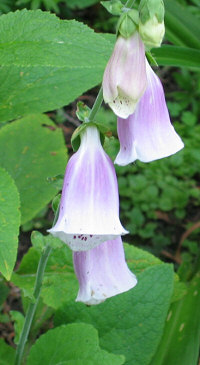
with: Iris, Geranium endressii (pink)
Are you looking for other options besides white Foxgloves? Try the links below for something suitable for your garden situation.
pink Foxgloves
yellow Foxgloves
ECHINACEA
  I love my white Purple Coneflowers! The dark green foliage is coarse but sets off the white ray-like flowers with the lovely bronzey-orange cone-like centres to perfection. Very long-blooming, if kept dead-headed, they deserve a prominent place in every border. Bonus - they attract both butterflies and bees. And, for me, they've repeatedly self-sown so my collection keeps growing.
Echinacea purpurea 'White Swan': white Coneflower
Additional Coneflowers can be found by following the links below.
pink Coneflower forms
various Coneflower forms
I love my white Purple Coneflowers! The dark green foliage is coarse but sets off the white ray-like flowers with the lovely bronzey-orange cone-like centres to perfection. Very long-blooming, if kept dead-headed, they deserve a prominent place in every border. Bonus - they attract both butterflies and bees. And, for me, they've repeatedly self-sown so my collection keeps growing.
Echinacea purpurea 'White Swan': white Coneflower
Additional Coneflowers can be found by following the links below.
pink Coneflower forms
various Coneflower forms
EREMURUS
The Foxtail Lily, also commonly known as Desert Candle and King's Spear, with its spikes of bloom above basal rosettes of foliage, adds a wonderful vertical element to a sunny sheltered garden site in late spring or early summer. Tuberous roots should be planted in fall in a hole 4-6 inches deep and 2 feet across. Well-drained, light, fertile soil is best. Drought-tolerant once established, it has forms of varying heights. Foliage dies back after bloom has finished so hide this perennial, wonderful when mass planted, at the rear of your border.
Eremurus himalaicus: white Foxtail Lily
interplanted with: Tulipa (cream-coloured) & a frontal planting of Pulmonaria 'Sissinghurst White'
behind: Paeonia (pink) and/or Thalictrum aquilegiafolium and/or Campanula lactiflora
For more information and plant partnership ideas follow the link to
Simply Special Perennials
FILIPENDULA
 Sometimes sold as False Spirea, Meadowsweet is an herb with structural, bold foliage that will persist throughout the growing season provided the moisture of its site is maintained. The summer-blooming flowers are sweetly scented and are available in a number of colours. Full sun to part shade is best as is well-drained but moist alkaline soil.
Filipendula: Meadowsweet
Sometimes sold as False Spirea, Meadowsweet is an herb with structural, bold foliage that will persist throughout the growing season provided the moisture of its site is maintained. The summer-blooming flowers are sweetly scented and are available in a number of colours. Full sun to part shade is best as is well-drained but moist alkaline soil.
Filipendula: Meadowsweet
where: moist to wet soils
with: Rosa, Iris, Hemerocallis, Phlox, Daisies
for untamed look with: ferns, Monarda, Campanula, Echinacea purpurea, Ornamental Grasses
Filipendula hexapetala: Double Dropwort, fluffy ivory-white flowers
synonym: Filipendula vulgaris 'Flore Pleno'
where: 3-5 together, 12" apart at a border edge
combined with: Paeonia, Iris sibirica, Thalictrum & Geranium spp.
Filipendula purpurea 'Elegans': Japanese Meadowsweet
where: as background, accent or waterside plant
Filipendula vulgaris: Dropwort, white, 2 to 3 feet tall
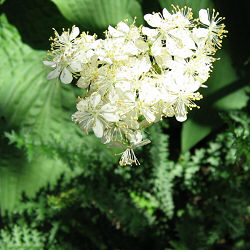
with: Nepeta x faassenii
For a change from white Meadowsweet, try the link below. Additional information on the page about growing this genus may be helpful.
pink Meadowsweet forms
GALIUM
Sweet Woodruff has wonderful, star-shaped leaves that are fragrant when dried. Dainty, white flowers appear in spring in layers along the stems. Growing only 6 to 12 inches high, it is a drought-tolerant groundcover that does well even in the dry shade of the cedar trees over our garden beds when other plants are drooping in the heat.
Galium odoratum: Sweet Woodruff
For useful information about siting and growing Sweet Woodruff, follow the link below.
Galium in shady situations
GAURA
White Gaura, with its long May-October bloom period, grows to 4 feet tall. Foliage is gray-green in colour. Tubular flowers appear in loose panicles that sway in the breeze. Sandy soil is preferred.
Gaura lindheimeri: White Gaura, Butterfly Gaura
where: with low-mounding perennials
with: Ornamental Grasses (esp. those that turn tawny in late summer)
with: small-flowered plants, i.e. Verbena spp, Limonium latifolium, Centranthus ruber, Sedum
with: Geranium
to echo with: Clematis 'Hagley Hybrid' (large soft pink blooms)
GERANIUM
I love perennial Geraniums, commonly called Cranesbills, for a number of reasons. First - after their spring to early-summer bloom is over you can cut the foliage back hard and encourage new fresh foliage to appear. Second - they are the perfect companion, planted in front of other perennials that bloom during the time the geranium's foliage is undergoing regrowth. Third - they come in so many colours and sizes that there are choices for every situation. Give them full sun with humusy, well-drained, evenly moist soil and enjoy the show they put on. And keep them well watered during dry spells.
Geranium x cantabrigiense 'Biokovo': a natural hybrid selection with white flowers
with: Rhododendron, Brunnera macrophylla
Geranium clarkei 'Kashmir White': Clarke's Cranesbill, pure white veined with lilac

this cultivar may be the beauty in the border around this page and in the images at the top of the page and directly above
with: green & white variegated Hosta
with: Iris x germanica (dark violet such as 'Dusky Dancer') & Paeonia (crimson-coloured)
with: Iris sibirica, instead of Bearded Iris for better foliage effect
Geranium sanguineum 'Album': Bloody Cranesbill, Blood-Red Cranesbill, white forms
in front of: Paeonia (white)
near: Iris sibirica (white), Rosa rugosa (white), Miscanthus sinensis
with: Paeonia (pink), Iris sibirica (blue) & Thalictrum aquilegiafolium
If you want to add several new perennial Geraniums to your gardens, as I do, you are sure to find many you'll like at the links below.
Geranium Profile
blue Geraniums
edging Geraniums
Geraniums for foliage effect
pink Geraniums
Geraniums for shade
Geranium "killer-combo"
GONIOLINUM
Although not a long-lived perennial, German Statice will serve as yet another valuable "filler" in the summer garden with its multitudes of tiny, silvery-white star-shaped flowers. This plant prefers a sunny site with rich, deep, well-drained soil. Propagate in spring either by seed or division.
Goniolinum tartaricum: German Statice, Zone 3, 15"x12", white forms
not a synonym for: Limonium latifolium which is Sea Lavender, or Statice
with: Allium tuberosum, Gaura lindheimeri, Iris, Phlox, Echinacea purpurea, Lilium, Helenium, Platycodon
behind: Salvia argentia
beside: Allium tuberosum
in front of: Sedum spectabile 'Stardust'
not beside: small-flowered Michaelmas Daisies, Chrysanthemum parthenium (they will dilute its effectiveness)
GYPSOPHILA
 The airy Baby's Breath is a wonderful addition to gardens and flower arrangements alike where it serves as an excellent "filler". Given full or partial sun and well-drained, neutral to alkaline soil that is somewhat dry it will draw the eye during its early to mid-summer bloom period, whether it is planted singly or in masses.
Gypsophila paniculata: Baby's Breath
The airy Baby's Breath is a wonderful addition to gardens and flower arrangements alike where it serves as an excellent "filler". Given full or partial sun and well-drained, neutral to alkaline soil that is somewhat dry it will draw the eye during its early to mid-summer bloom period, whether it is planted singly or in masses.
Gypsophila paniculata: Baby's Breath
use to: blur edges and tone down stronger colors
to hide yellowing foliage: of bulbs & other dormant plants i.e. Papaver orientale, Dicentra spectabilis
generally with: bold and spiky perennials for dramatic effect
with: Campanula (taller forms), Coreopsis lanceolata, Liatris, Lilium, Veronica
with: Echinacea purpurea, Chrysanthemum x superbum, Aster, late spring bulbs
combined with: Paeonia & Echinacea purpurea alba
combined with: Lilium martagon (ivory), Monarda didyma (red) & Delphinium (blue)
combined with: Lythrum virgatum, Lilium martagon (lemon-yellow Turk's Cap Lily) & Stachys byzantina (silver)
with: Delphinium (tall, sky-blue), Lilium (deep red) & pink rambling roses
Gypsophila paniculata 'Double White': Baby's Breath
with: herbs, blue Salvia & roses
Gypsophila paniculata 'Perfecta': double white Baby's Breath
combined with: Echinacea purpurea 'White Swan' & Lysimachia clethroides
If you are only familiar with white Baby's Breath, follow the link below for another option.
pink Baby's Breath
Baby's Breath with silver foliage
HEMEROCALLIS
 Even though we commonly add daylilies of various colours and colour combinations to our gardens, we often neglect the white forms, ranging from creamy tones to pristine pure white.
Some of the daylilies below are Spider and Unusual Form Daylilies. Follow the link to learn more about the beautiful cultivars available in these two classes and see images that show their amazing appearance. You will also discover how to find suppliers of these classes in your area.
Hemerocallis 'Asterisk': white with grayish cast & green throat
Even though we commonly add daylilies of various colours and colour combinations to our gardens, we often neglect the white forms, ranging from creamy tones to pristine pure white.
Some of the daylilies below are Spider and Unusual Form Daylilies. Follow the link to learn more about the beautiful cultivars available in these two classes and see images that show their amazing appearance. You will also discover how to find suppliers of these classes in your area.
Hemerocallis 'Asterisk': white with grayish cast & green throat
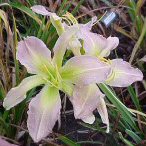
this Unusual Form Spatulate cultivar was registered in 1985, scape height 28", bloom 8", bloom season M
Hemerocallis 'Heavenly Angel Ice': white self above green yellow throat, scape height 36", Rebloomer
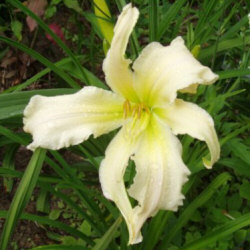
this Unusual Form Crispate cultivar was registered in 2004, bloom 8", season MLa
Hemerocallis 'Joan Senior': a white Daylily
Hemerocallis 'Raspberry Griffin': cream near white with raspberry eye and edge above green throat, Fragrant Rebloomer
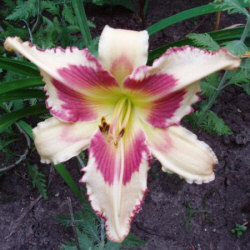
this Unusual Form Crispate cultivar was registered in 2006, scape height 27", bloom 7.5", season EM
Hemerocallis 'Tylwyth Teg': pale cream rainbow polychrome with lavender midribs & pale gold throat

this Spider cultivar was registered in 1988, Spider Ratio 5.60:1, scape height 40", bloom 8", season M
There is a wealth of colour choice in the Daylily genus. As proof see the links below.
various Daylilies
orange Daylilies
pink Daylilies
purple Daylilies
red Daylilies
Spider and Unusual Form Daylilies
yellow Daylilies
HEUCHERA
  Taylor's Guide to Growing NORTH AMERICA'S Favorite Plants states that "Heucheras grown for their flowers are commonly called coralbells, while those grown for their foliage are typically referred to as alumroots or simply heucheras". The many different species of Coral Bells often have a number of white-flowered choices. The mound-shaped foliage serves as a base from which erect stems arise, with panicles of dainty flowers held high above. Cut back to the base of the stems to encourage more blooms to appear.
Heuchera 'Palace Purple': Alumroot, Coral Bells
Heuchera x brizoides 'June Bride': white Hybrid Coral Bells
From beautiful foliage to lovely flower colours, there are choices galore at the links below.
Taylor's Guide to Growing NORTH AMERICA'S Favorite Plants states that "Heucheras grown for their flowers are commonly called coralbells, while those grown for their foliage are typically referred to as alumroots or simply heucheras". The many different species of Coral Bells often have a number of white-flowered choices. The mound-shaped foliage serves as a base from which erect stems arise, with panicles of dainty flowers held high above. Cut back to the base of the stems to encourage more blooms to appear.
Heuchera 'Palace Purple': Alumroot, Coral Bells
Heuchera x brizoides 'June Bride': white Hybrid Coral Bells
From beautiful foliage to lovely flower colours, there are choices galore at the links below.
Coral Bells as edgers
Coral Bells to attract Hummingbirds
pink Coral Bell forms
purple Coral Bell forms
red Coral Bell forms
Coral Bells with silver foliage
Coral Bells with variegated foliage
IBERIS
 Narrow leaves are part of the attraction of the perennial Candytuft. Very low-growing, it makes a wonderful white edger in early to mid-spring, perfect for rock or wall gardens as well as borders. Provide it with full sun and somewhat acidic soil. For density cut back stems after flowering has finished. The cultivar 'Autumn Beauty', as its name suggests, will rebloom in fall.
Iberis sempervirens: Candytuft, Perennial Candytuft
Iberis sempervirens Alexander's White'
Iberis sempervirens 'Snowflake'
For spring interest at a garden edge you might want to try this beauty. Check out the plant partnerships recommended for contrast or complementary colour.
Perennial Candytuft edging
Narrow leaves are part of the attraction of the perennial Candytuft. Very low-growing, it makes a wonderful white edger in early to mid-spring, perfect for rock or wall gardens as well as borders. Provide it with full sun and somewhat acidic soil. For density cut back stems after flowering has finished. The cultivar 'Autumn Beauty', as its name suggests, will rebloom in fall.
Iberis sempervirens: Candytuft, Perennial Candytuft
Iberis sempervirens Alexander's White'
Iberis sempervirens 'Snowflake'
For spring interest at a garden edge you might want to try this beauty. Check out the plant partnerships recommended for contrast or complementary colour.
Perennial Candytuft edging
IRIS
 Because this genus is so varied you should buy a good reference book on the Iris alone or borrow one from your local library if you intend to grow many of these wonderful perennials. This will be invaluable to learn the requirements of soil, moisture and exposure for all types to decide which will perform best in your garden conditions. You will no doubt find many white forms in such reference material in addition to those below.
Iris: a white plicata form with lavender "stitching"
Because this genus is so varied you should buy a good reference book on the Iris alone or borrow one from your local library if you intend to grow many of these wonderful perennials. This will be invaluable to learn the requirements of soil, moisture and exposure for all types to decide which will perform best in your garden conditions. You will no doubt find many white forms in such reference material in addition to those below.
Iris: a white plicata form with lavender "stitching"

seen above in front of: Baptisia australis to echo its lavender-blue tones
Iris 'Ermine Robe': huge, pure white Bearded Iris, 38", mid-late bloom
combined with: Iris 'Dusky Challenger' & Iris 'New Moon'
Iris 'Lacy Snowflake':
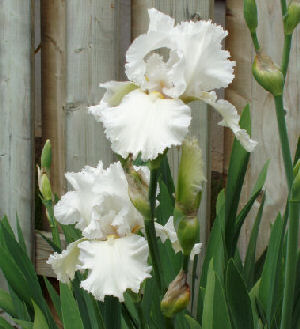
with: any of the same combinations as those mentioned above or below
Iris 'Lady Madonna': icy white, gold heart, gold-edged ruffles, 4'
with: any other Iris, but especially those with gold colour to echo its golden halo
What's your favourite flower colour? Or foliage colour? There are sure to be many Irises at the links below which will suit your preference. In a drift with many of the same colour, or partnered with any of the perennials recommended by gardening experts, all of these forms will add richness and appeal to every island, border or bed in which they are used.
blue Iris
bulbous Iris
Iris for edging
orange Iris
purple Iris
red Iris
yellow Iris
Iris with variegated foliage
FOR MORE WHITE PERENNIALS & THEIR COMPANIONS, FOLLOW THE LINK BELOW.
All of our own Gardens By The Bay pages can be accessed by clicking on the links below.
HOME
GARDEN POETRY |
GARDEN POETRY MUSE
GEORGIAN BAY VIEW
BOTANICAL LATIN - BASICS
COLOR THEORY
THE GARDENS
CORNER GARDEN CONSTRUCTION |
CORNER GARDEN PLANTING |
LONG GARDEN
EAST GARDEN |
HOSTA GARDEN |
NORTH GARDEN |
WINTER GARDENS
PLANT PARTNERSHIPS
BLUE PERENNIALS Aconitum -
Geranium |
Iris - Vinca
BULBS Allium - Hyacinthus |
Narcissus only |
Tulipa only |
Minor Bulbs
BUTTERFLY MAGNETS Anaphalis - Hemerocallis |
Liatris - Veronicastrum
 DAYLILIES Spider & Unusual Form DAYLILIES Spider & Unusual Form EDGERS Arabis - Iris |
Nepeta - Veronica
FOLIAGE PERENNIALS
Alchemilla - Tanacetum
HOSTA Hosta - all
HUMMINGBIRD-FRIENDLY PERENNIALS Alcea - Salvia
ORANGE PERENNIALS Achillea - Tulipa
ORNAMENTAL GRASSES Acorus - Imperata |
Miscanthus - Spodiopogon
PINK PERENNIALS Achillea - Lilium |
Lychnis - Veronica
PURPLE PERENNIALS Aconitum - Liatris |
Polemonium - Veronica
RED PERENNIALS Achillea - Veronica
SHADE PERENNIALS Aegopodium - Erythronium |
Ferns - Polemonium |
Polygonatum - Vinca
SILVER FOLIAGE PERENNIALS
Achillea - Cerastium
|
Cornus - Limonium
|
Lunaria - Veronica
SIMPLY SPECIAL PERENNIALS Acanthus - Saxifraga
WHITE PERENNIALS Achillea - Iris |
Kalimeris - Yucca
YELLOW PERENNIALS Achillea - Hypericum |
Inula - Verbascum
VARIEGATED-FOLIAGE PERENNIALS Acorus - Erythronium |
Hakonechloa - Lysimachia |
Miscanthus - Yucca
PLANT PROFILES
Dianthus 'Tiny Rubies' |
Geranium |
Geum coccineum |
Kerria japonica |
Knautia macedonica
Paeonia tenuifolia |
Papaver somniferum |
Rudbeckia |
Salvia 'East Friesland'
Trollius |
Veronica 'Sunny Border Blue'
PROPAGATION
DIVISION - SPRING ONLY |
DIVISION - FALL ONLY |
DIVISION - SPRING OR FALL |
DO NOT DIVIDE
FERTILIZATION
EDGERS Arabis - Iris |
Nepeta - Veronica
FOLIAGE PERENNIALS
Alchemilla - Tanacetum
HOSTA Hosta - all
HUMMINGBIRD-FRIENDLY PERENNIALS Alcea - Salvia
ORANGE PERENNIALS Achillea - Tulipa
ORNAMENTAL GRASSES Acorus - Imperata |
Miscanthus - Spodiopogon
PINK PERENNIALS Achillea - Lilium |
Lychnis - Veronica
PURPLE PERENNIALS Aconitum - Liatris |
Polemonium - Veronica
RED PERENNIALS Achillea - Veronica
SHADE PERENNIALS Aegopodium - Erythronium |
Ferns - Polemonium |
Polygonatum - Vinca
SILVER FOLIAGE PERENNIALS
Achillea - Cerastium
|
Cornus - Limonium
|
Lunaria - Veronica
SIMPLY SPECIAL PERENNIALS Acanthus - Saxifraga
WHITE PERENNIALS Achillea - Iris |
Kalimeris - Yucca
YELLOW PERENNIALS Achillea - Hypericum |
Inula - Verbascum
VARIEGATED-FOLIAGE PERENNIALS Acorus - Erythronium |
Hakonechloa - Lysimachia |
Miscanthus - Yucca
PLANT PROFILES
Dianthus 'Tiny Rubies' |
Geranium |
Geum coccineum |
Kerria japonica |
Knautia macedonica
Paeonia tenuifolia |
Papaver somniferum |
Rudbeckia |
Salvia 'East Friesland'
Trollius |
Veronica 'Sunny Border Blue'
PROPAGATION
DIVISION - SPRING ONLY |
DIVISION - FALL ONLY |
DIVISION - SPRING OR FALL |
DO NOT DIVIDE
FERTILIZATION
BULBS |
ORNAMENTAL GRASSES |
PERENNIALS |
SHRUBS |
VINES
LINKS
GARDENS |
LOCAL GARDENS |
BOTANICAL TERMINOLOGY
GARDENING BOOKS |
NON-GARDENING
HOME
|
|
|